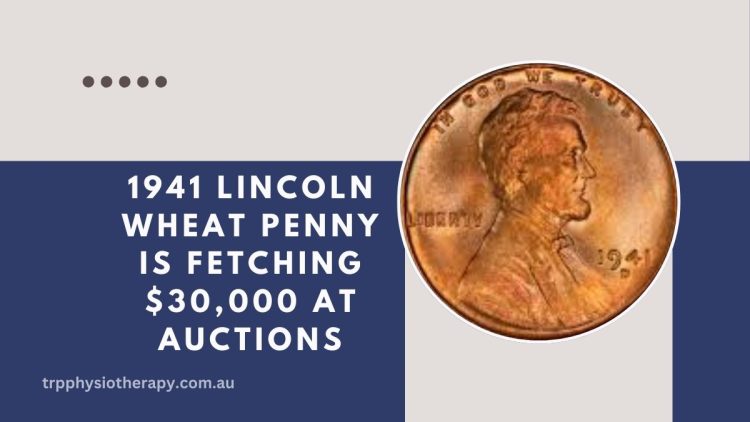The 1941 Lincoln Wheat Penny has recently captivated collectors and investors alike, with some specimens commanding prices as high as $30,000 at auctions.
This remarkable valuation stems from a combination of historical significance, rarity, condition, and unique errors. Let’s delve into the factors that contribute to the extraordinary worth of this coin.
Historical Significance of the 1941 Lincoln Wheat Penny
Introduced in 1909 to commemorate the centennial of President Abraham Lincoln’s birth, the Lincoln Wheat Penny was the first U.S. coin to feature a president’s portrait.
Designed by Victor David Brenner, the coin’s obverse showcases Lincoln’s profile, while the reverse displays two wheat stalks, symbolizing prosperity.
The 1941 edition holds particular interest as it was minted on the brink of the United States’ entry into World War II, marking a pivotal moment in American history.
Mintage and Mint Marks
In 1941, the production of Lincoln Wheat Pennies surpassed 1 billion coins for the first time, with the following mintage figures:
| Mint Location | Mint Mark | Mintage Quantity |
|---|---|---|
| Philadelphia | None | 887,018,000 |
| Denver | D | 128,700,000 |
| San Francisco | S | 92,360,000 |
Despite these substantial numbers, only a fraction of these coins have survived in pristine condition, significantly enhancing their value among collectors.
Factors Elevating the 1941 Penny’s Value
Several critical factors contribute to the heightened value of certain 1941 Lincoln Wheat Pennies:
- Condition and Grading: Coins are meticulously evaluated based on their preservation state. The Sheldon Scale, ranging from 1 to 70, is employed for this purpose. Coins graded MS68RD (Mint State 68 Red) are exceptionally rare and have fetched substantial sums at auctions.
- Rare Errors and Varieties:
- Doubled Die Obverse (DDO): This error results from the die striking the coin’s surface multiple times, causing noticeable doubling on inscriptions like “LIBERTY” and “IN GOD WE TRUST.” High-grade DDO specimens can command prices ranging from $275 to $2,400, depending on their condition.
- Shifted Digit: A rare anomaly where the last digit of the minting year appears slightly shifted, particularly found in San Francisco-minted coins. Such pieces are valued at approximately $300.
- Experimental Planchets: Due to wartime metal shortages, the U.S. Mint experimented with various metal compositions. Some 1941 pennies were struck on these experimental planchets, making them highly sought after, with values reaching up to $600.
- Coloration: The coin’s color significantly impacts its desirability:
- Brown (BN): Common and less valuable.
- Red-Brown (RB): Moderately valued.
- Red (RD): Highly prized, especially in uncirculated conditions.
Notable Auction Sales
The allure of the 1941 Lincoln Wheat Penny is exemplified by remarkable auction results:
- In January 2025, a 1941 Lincoln Cent graded MS68RD by PCGS realized $15,600 at a Heritage Auctions event.
- A 1918 Lincoln Cent in MS68RD condition achieved $31,200 in a Stack’s Bowers auction, underscoring the premium placed on high-grade, early 20th-century cents.
Collecting and Investing in the 1941 Lincoln Wheat Penny
For enthusiasts and investors aiming to acquire a valuable 1941 Lincoln Wheat Penny, consider the following:
- Authentication: Ensure the coin is certified by reputable grading services like PCGS or NGC to verify its authenticity and condition.
- Condition Focus: Target coins in the highest possible grades, preferably MS65RD or above, to maximize potential value.
- Error Varieties: Seek out coins with recognized errors, such as the Doubled Die Obverse, as these are rarer and more valuable.
The 1941 Lincoln Wheat Penny exemplifies how historical context, rarity, condition, and unique errors can converge to create a numismatic treasure.
While many of these pennies remain common, exceptional specimens, particularly those with rare errors and in superb condition, can achieve astonishing prices at auction.
For collectors and investors, understanding these nuances is crucial to identifying and acquiring these valuable pieces of American history.
FAQs
How can I determine if my 1941 Lincoln Wheat Penny is valuable?
Assess your coin’s condition, mint mark, and any errors. Coins in mint state (uncirculated) with a red coloration and those exhibiting errors like the Doubled Die Obverse are typically more valuable. Consulting a professional grading service can provide an accurate evaluation.
Are all 1941 Lincoln Wheat Pennies valuable?
While standard circulated 1941 pennies are common and hold minimal value, those in exceptional condition or with rare errors can be highly valuable. The presence of a mint mark and the coin’s color also influence its worth.
Where can I sell a high-value 1941 Lincoln Wheat Penny?
High-value coins are best sold through reputable auction houses specializing in numismatics or through established coin dealers. Ensure your coin is certified by a recognized grading service to facilitate a transparent and trustworthy transaction.

